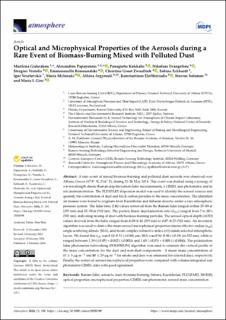| dc.contributor.author | Gidarakou, Marilena | |
| dc.contributor.author | Papayannis, Alexandros | |
| dc.contributor.author | Kokkalis, Panagiotis | |
| dc.contributor.author | Evangeliou, Nikolaos | |
| dc.contributor.author | Vratolis, Stergios | |
| dc.contributor.author | Remoundaki, Emmanouella | |
| dc.contributor.author | Zwaaftink, Christine Groot | |
| dc.contributor.author | Eckhardt, Sabine | |
| dc.contributor.author | Veselovskii, Igor | |
| dc.contributor.author | Mylonaki, Maria | |
| dc.contributor.author | Argyrouli, Athina | |
| dc.contributor.author | Eleftheriadis, Konstantinos | |
| dc.contributor.author | Solomos, Stavros | |
| dc.contributor.author | Gini, Maria | |
| dc.date.accessioned | 2024-02-26T08:59:34Z | |
| dc.date.available | 2024-02-26T08:59:34Z | |
| dc.date.created | 2024-02-19T16:10:48Z | |
| dc.date.issued | 2024 | |
| dc.identifier.citation | Atmosphere. 2024, 15, 190. | en_US |
| dc.identifier.issn | 2073-4433 | |
| dc.identifier.uri | https://hdl.handle.net/11250/3119815 | |
| dc.description.abstract | A rare event of mixed biomass-burning and polluted dust aerosols was observed over Athens, Greece (37.9° N, 23.6° E), during 21–26 May 2014. This event was studied using a synergy of a 6-wavelength elastic-Raman-depolarization lidar measurements, a CIMEL sun photometer, and in situ instrumentation. The FLEXPART dispersion model was used to identify the aerosol sources and quantify the contribution of dust and black carbon particles to the mass concentration. The identified air masses were found to originate from Kazakhstan and Saharan deserts, under a rare atmospheric pressure system. The lidar ratio (LR) values retrieved from the Raman lidar ranged within 25–89 sr (355 nm) and 35–70 sr (532 nm). The particle linear depolarization ratio (δaer) ranged from 7 to 28% (532 nm), indicating mixing of dust with biomass-burning particles. The aerosol optical depth (AOD) values derived from the lidar ranged from 0.09–0.43 (355 nm) to 0.07–0.25 (532 nm). An inversion algorithm was used to derive the mean aerosol microphysical properties (mean effective radius (reff), single scattering albedo (SSA), and mean complex refractive index (m)) inside selected atmospheric layers. We found that reff was 0.12–0.51 (±0.04) µm, SSA was 0.94–0.98 (±0.19) (at 532 nm), while m ranged between 1.39 (±0.05) + 0.002 (±0.001)i and 1.63 (±0.05) + 0.008 (±0.004)i. The polarization lidar photometer networking (POLIPHON) algorithm was used to estimate the vertical profile of the mass concentration for the dust and non-dust components. A mean mass concentration of 15 ± 5 μg m−3 and 80 ± 29 μg m−3 for smoke and dust was estimated for selected days, respectively. Finally, the retrieved aerosol microphysical properties were compared with column-integrated sun photometer CIMEL data with good agreement | en_US |
| dc.description.abstract | Optical and Microphysical Properties of the Aerosols during a Rare Event of Biomass-Burning Mixed with Polluted Dust | en_US |
| dc.language.iso | eng | en_US |
| dc.rights | Navngivelse 4.0 Internasjonal | * |
| dc.rights.uri | http://creativecommons.org/licenses/by/4.0/deed.no | * |
| dc.title | Optical and Microphysical Properties of the Aerosols during a Rare Event of Biomass-Burning Mixed with Polluted Dust | en_US |
| dc.title.alternative | Optical and Microphysical Properties of the Aerosols during a Rare Event of Biomass-Burning Mixed with Polluted Dust | en_US |
| dc.type | Peer reviewed | en_US |
| dc.type | Journal article | en_US |
| dc.description.version | publishedVersion | en_US |
| dc.rights.holder | © 2024 by the authors. Licensee MDPI, Basel, Switzerland. | en_US |
| dc.source.volume | 15 | en_US |
| dc.source.journal | Atmosphere | en_US |
| dc.identifier.doi | 10.3390/atmos15020190 | |
| dc.identifier.cristin | 2247722 | |
| dc.relation.project | EU – Horisont Europa (EC/HEU): 101081395 | en_US |
| dc.relation.project | EC/H2020/101008004 | en_US |
| dc.relation.project | NILU: 123005 | en_US |
| dc.relation.project | NILU: 121001 | en_US |
| dc.source.articlenumber | 190 | en_US |
| cristin.ispublished | true | |
| cristin.fulltext | original | |
| cristin.qualitycode | 1 | |

